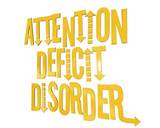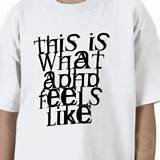What Causes Attention Deficit Disorder?


What Causes Attention Deficit Hyperactivity Disorder?
(ADHD) is a developmental condition of inattention and distraction, with or without accompanying hyperactivity. A syndrome, usually diagnosed in childhood, characterized by a persistent pattern of impulsiveness, short attention span, hyperactivity, and interfering especially with academic, occupational, and social performance. Adults' symptoms may manifest themselves differently from children's.
In the not too distant past, various terms were used to describe this condition, including hyperactive syndrome, or "minimal brain dysfunction." It's probably best recognized by the term Attention Deficit Disorder (ADD). More recently, attention has focused on adult forms of ADHD, which probably have been under diagnosed.
Although the exact prevalence in adults is unknown, studies reveal the condition is marked by inattentiveness, difficulty getting work done, procrastination, organizational difficulties, and probably exists in about 2-4% of adults.
Often the most prominent characteristic in ADHD adults is difficulty with executive functioning, which is the brain activity overseeing the ability to monitor a person's own behavior by planning and organizing.
Other symptoms observed in adults included inattention, impulsive reactions, and restlessness as well as regular accompanying behavioral, learning, and emotional difficulties.
Adults with hyperactive-impulsive symptoms feel restless and constantly "on the go" as they try to do multiple tasks at once. They are often perceived as not thinking before they act or speak.
Many think of hyperactive children who fidget and can’t sit still when thinking of attention deficit hyperactivity disorder, or ADHD. However, symptoms of ADHD can persist into adulthood. In fact, many adults with ADHD don’t realize many problems they face, including staying organized or being on time, are symptoms of adult ADHD.
What Causes It?
While experts aren't certain what causes ADHD, they believe genes may play an important party. It's believed environmental issues, such as exposure to cigarettes, alcohol, or other toxins while in the womb, may also play a role. Unlike other psychiatric disorders, like anxiety and depression, ADHD doesn't begin in adulthood. So symptoms must have been present since childhood for a diagnosis of adult ADHD to be made.
The most common conventionally used diagnostic criteria for ADHD were developed on how the condition displayed itself in youngsters. These symptoms included:
-
Forgetfulness
-
Excessive Daydreaming
-
Inability to Sit Still
-
Constant Fidgeting
Yet, numerous experts believe ADHD symptoms manifest differently and more subtly. This makes it tough to diagnose.
The diagnosis of ADD must be made very carefully. Not all “hyperactive” children have it, which is a biologically-based problem. In some cases, so-called hyperactivity, which may include behavior such as tantrums, disobedience, ignoring instructions, hitting, kicking, and other forms of acting out, may actually be the result of a combination of learned behavior and poor discipline techniques.
Hyperactive behavior may be caused by medical factors, psychological factors, or a combination of both. If biological factors are the problem, for example, a malfunctioning reticular activating system (RAS) or a dopamine imbalance, medication is needed. If learning is the problem, new child management skills are required. If both learning and biology are involved, medication and management techniques must be used in combination.
The popular term for ADD is hyperactivity, but the most precise designation is “attention deficit hyperactivity disorder.” The causes of ADD are not completely understood, but researchers have identified three likely sources:
-
An overactive reticular activating system. The RAS is a specialized structure running throughout the brain stem. Its function is to monitor incoming three information. That information floods the high centers of the brain so the individual isn't able to focus on one piece of information before being overwhelmed by the next. The result: decreased attention span, edginess, hyperactivity, and irritability.
-
An under active reticular activating system. Paradoxically, an under active RAS is considered a far more common trigger for ADD than an overactive RAS. An individual with an under aroused RAS experiences stimulation hunger. The desire for stimulation triggers hyperactive behavior as the brain struggles to drink in more information. Thus, when certain stimulants are given to a hyperactive child, the brain gets adequate data from normal behavior and the hyperactivity ceases. The drug most commonly prescribed for ADD is Ritalin, a stimulant that calms hyperactive behavior and increases attention span. Ritalin has proven to be a highly effective therapy for ADD, although the dosage of the drug must be carefully fine-tuned by the physician to the patient's individual needs.
-
Dopamine imbalance. Another potential cause or contributing factor behind ADD is an imbalance of a brain chemical, the neurotransmitter dopamine.








